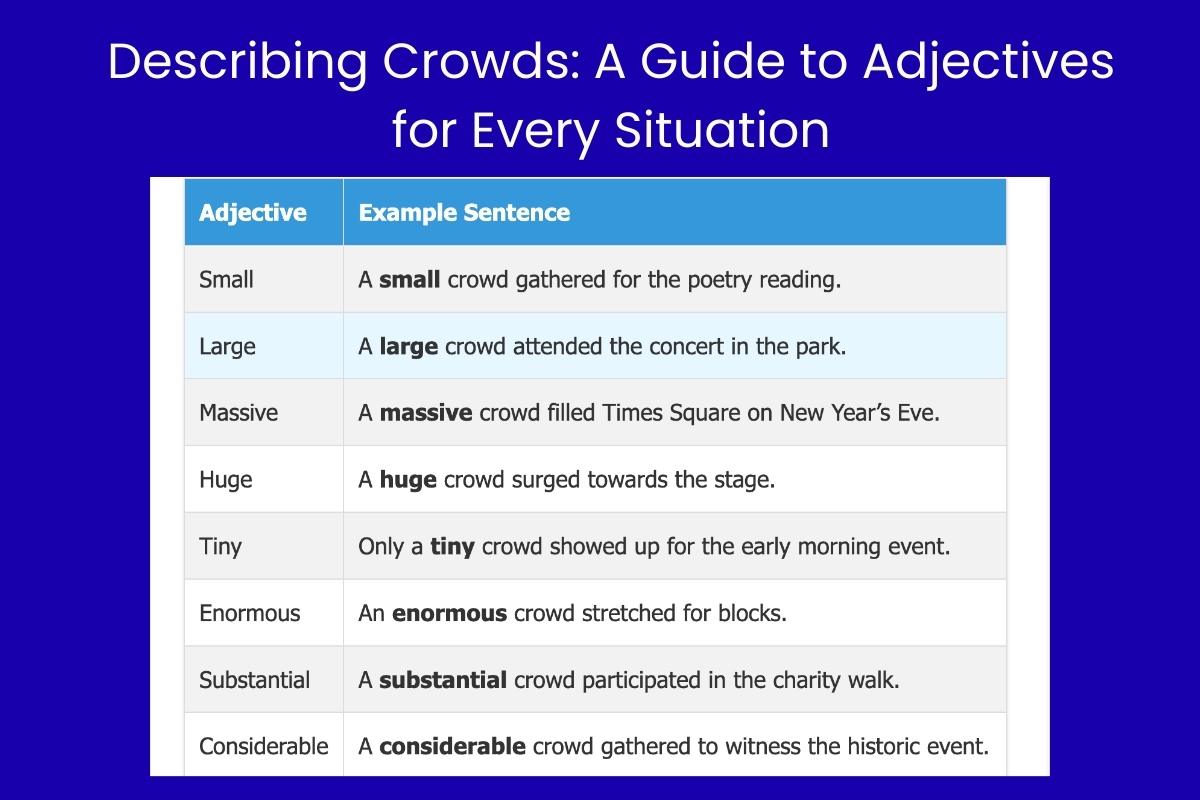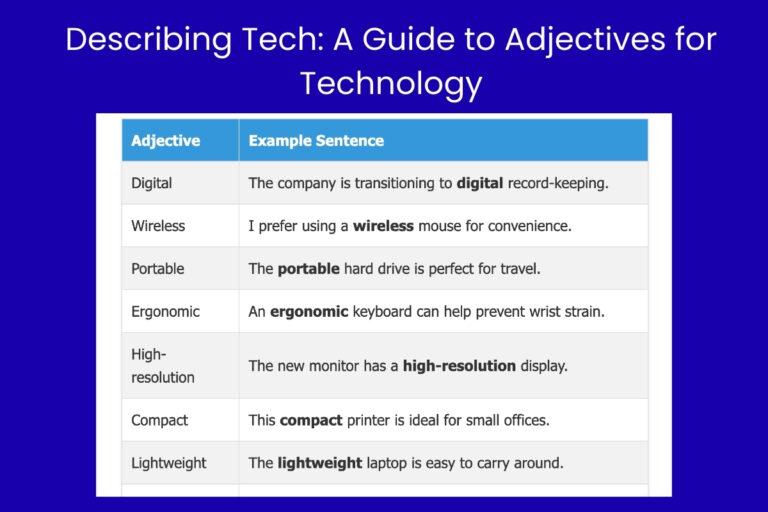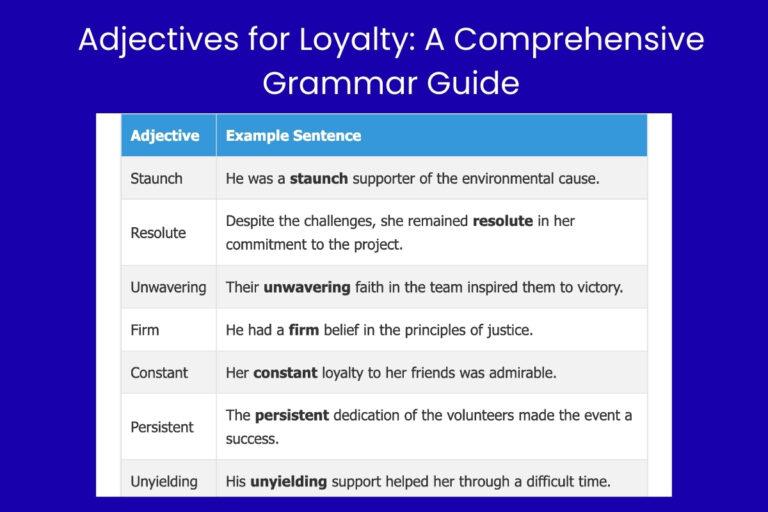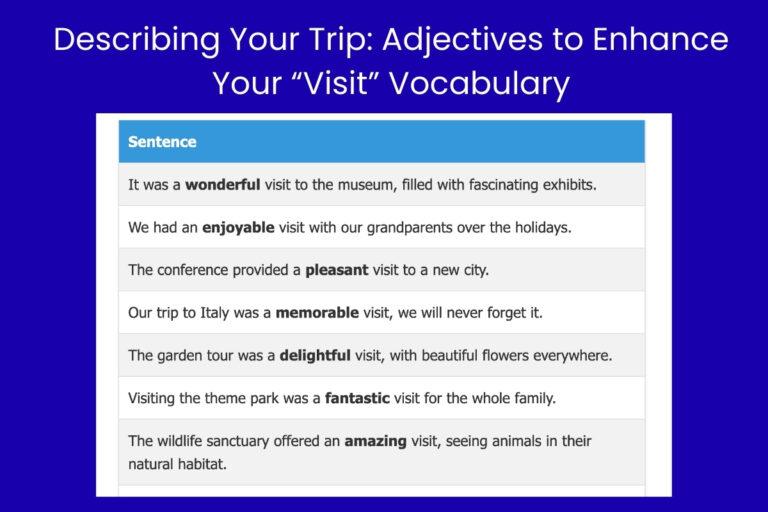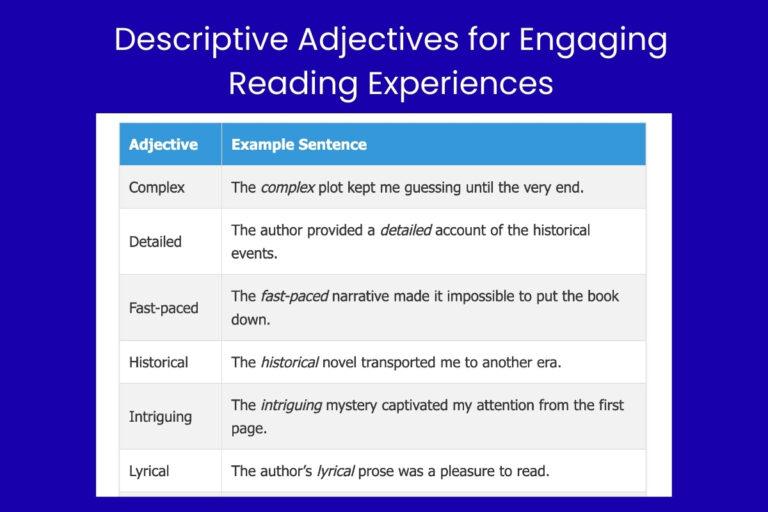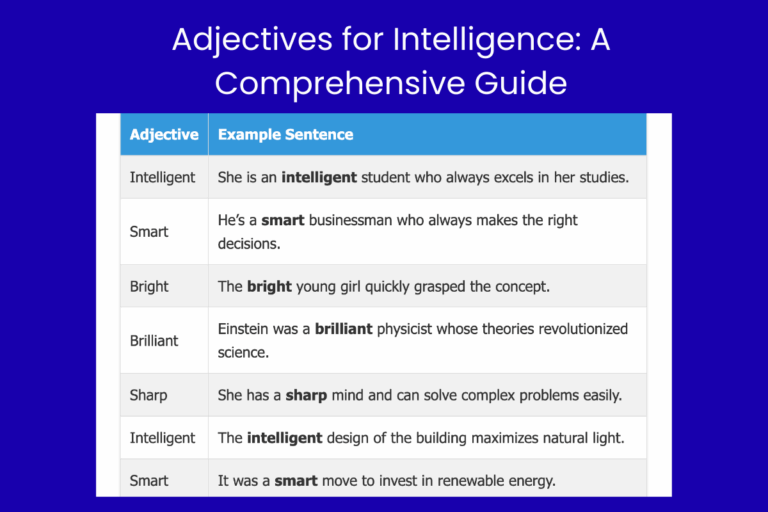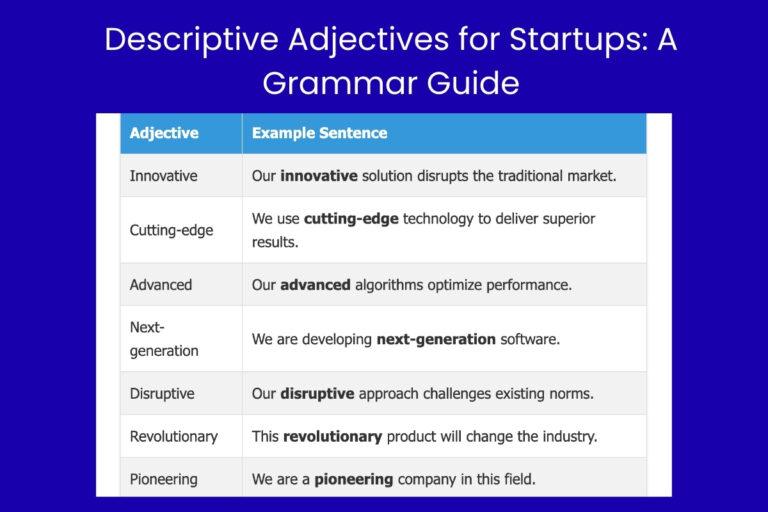Describing Crowds: A Guide to Adjectives for Every Situation
Choosing the right adjective to describe a crowd can significantly enhance your writing, providing vivid details and conveying specific impressions. Whether you’re depicting a bustling marketplace, a peaceful gathering, or a chaotic protest, the adjectives you select paint a clearer picture for your audience. This article delves into the diverse range of adjectives used to describe crowds, exploring their meanings, nuances, and appropriate contexts. By understanding these adjectives, you can master the art of descriptive writing and communicate more effectively.
This comprehensive guide is designed for English language learners, writers, and anyone interested in expanding their vocabulary and improving their descriptive skills. We will cover various types of adjectives, provide numerous examples, and offer practical exercises to solidify your understanding. Let’s embark on this journey to master the art of describing crowds with precision and flair.
Table of Contents
- Introduction
- Definition of Adjectives for Crowds
- Structural Breakdown
- Types and Categories of Adjectives for Crowds
- Examples of Adjectives for Crowds
- Usage Rules for Adjectives for Crowds
- Common Mistakes When Using Adjectives for Crowds
- Practice Exercises
- Advanced Topics
- Frequently Asked Questions
- Conclusion
Definition of Adjectives for Crowds
An adjective is a word that modifies a noun or pronoun, providing more information about it. When describing crowds, adjectives help to convey the size, behavior, emotional state, appearance, and organization of the group. They add depth and detail, enabling the reader or listener to visualize the scene more vividly. The choice of adjective can dramatically alter the perception of the crowd, influencing the overall tone and message.
Adjectives can be classified based on their function and the type of information they provide. Some adjectives describe the physical characteristics of the crowd, such as its size (massive, small) or appearance (diverse, uniform). Other adjectives describe the crowd’s behavior (rowdy, peaceful) or emotional state (excited, anxious). Understanding these classifications helps in selecting the most appropriate adjective for a given context.
The context in which an adjective is used is crucial. For example, the adjective “dense” can describe the physical compactness of a crowd, while “unruly” describes its behavior. The specific situation and the intended meaning will dictate the most suitable adjective. Paying close attention to context ensures that the chosen adjective accurately reflects the characteristics of the crowd being described.
Structural Breakdown
Adjectives typically precede the noun they modify (attributive position), but they can also follow a linking verb such as “be,” “seem,” or “become” (predicative position). For example, in the sentence “The massive crowd gathered in the square,” the adjective “massive” is in the attributive position. In the sentence “The crowd was enthusiastic,” the adjective “enthusiastic” is in the predicative position.
Adjectives can be modified by adverbs to add further nuance. For example, in the phrase “incredibly large crowd,” the adverb “incredibly” modifies the adjective “large,” intensifying its meaning. This allows for a more precise and descriptive portrayal of the crowd.
In some cases, multiple adjectives can be used to describe a crowd, providing a more detailed and comprehensive picture. These adjectives are typically separated by commas or connected by conjunctions such as “and.” For example, “The large, enthusiastic, and diverse crowd filled the stadium.” The order of adjectives can sometimes follow general guidelines, such as opinion before fact (e.g., “beautiful large crowd” sounds more natural than “large beautiful crowd”).
Types and Categories of Adjectives for Crowds
Adjectives for crowds can be categorized based on the aspects they describe. Here are some primary categories:
Adjectives Describing Size
These adjectives indicate the quantity or extent of the crowd. They help to convey whether the crowd is small and intimate or large and overwhelming.
Adjectives Describing Behavior
These adjectives describe how the crowd is acting or behaving. They can depict the crowd as orderly or chaotic, peaceful or aggressive.
Adjectives Describing Emotion
These adjectives convey the emotional state of the crowd. They indicate the overall mood or feeling that the crowd is experiencing.
Adjectives Describing Appearance
These adjectives describe the visual characteristics of the crowd, such as its diversity, uniformity, or attire.
Adjectives Describing Organization
These adjectives describe how the crowd is structured or arranged. They indicate whether the crowd is orderly, disorganized, or tightly packed.
Examples of Adjectives for Crowds
To illustrate the use of different types of adjectives for crowds, let’s explore examples within each category.
Size Adjectives Examples
The following table provides examples of adjectives that describe the size of a crowd, along with illustrative sentences. These examples show how different adjectives can convey varying degrees of size and scale.
| Adjective | Example Sentence |
|---|---|
| Small | A small crowd gathered for the poetry reading. |
| Large | A large crowd attended the concert in the park. |
| Massive | A massive crowd filled Times Square on New Year’s Eve. |
| Huge | A huge crowd surged towards the stage. |
| Tiny | Only a tiny crowd showed up for the early morning event. |
| Enormous | An enormous crowd stretched for blocks. |
| Substantial | A substantial crowd participated in the charity walk. |
| Considerable | A considerable crowd gathered to witness the historic event. |
| Immense | An immense crowd celebrated the victory. |
| Compact | The compact crowd made it difficult to move around. |
| Scattered | A scattered crowd remained after the main event. |
| Sparse | A sparse crowd attended the outdoor movie screening. |
| Populous | The populous crowd made navigating the streets challenging. |
| Numerous | Numerous crowds flocked to the city center for the festival. |
| Countless | Countless crowds have walked through these historic streets. |
| Voluminous | A voluminous crowd packed the stadium. |
| Extensive | An extensive crowd lined the parade route. |
| Widespread | A widespread crowd covered the entire field. |
| Thick | A thick crowd surrounded the performers. |
| Full | The auditorium was full of people. |
| Packed | The train was packed with commuters. |
| Congested | The streets were congested with shoppers. |
| Amplified | The speaker’s voice was amplified for the large crowd. |
| Teeming | The marketplace was teeming with vendors and shoppers. |
| Overflowing | The venue was overflowing with enthusiastic fans. |
Behavior Adjectives Examples
The following table provides examples of adjectives that describe the behavior of a crowd, along with illustrative sentences. These examples demonstrate how different adjectives can convey the actions and demeanor of a group.
| Adjective | Example Sentence |
|---|---|
| Rowdy | A rowdy crowd disrupted the peace with their shouting. |
| Peaceful | A peaceful crowd marched silently in protest. |
| Excited | An excited crowd cheered as the band took the stage. |
| Boisterous | A boisterous crowd celebrated the victory with loud cheers. |
| Calm | A calm crowd listened attentively to the speaker. |
| Unruly | An unruly crowd pushed against the barriers. |
| Orderly | An orderly crowd waited patiently in line. |
| Restless | A restless crowd grew impatient as the delay continued. |
| Animated | An animated crowd discussed the issues passionately. |
| Subdued | A subdued crowd mourned the loss of their leader. |
| Frenzied | A frenzied crowd rushed to grab the free merchandise. |
| Rambunctious | The rambunctious crowd made it hard to hear the speaker. |
| Well-behaved | The well-behaved crowd listened attentively to the presentation. |
| Disruptive | The disruptive crowd caused chaos at the event. |
| Turbulent | A turbulent crowd clashed with the police. |
| Agitated | An agitated crowd demanded answers from the officials. |
| Responsive | A responsive crowd cheered and applauded enthusiastically. |
| Unresponsive | An unresponsive crowd showed little interest in the performance. |
| Moving | A moving crowd slowly made its way through the streets. |
| Static | A static crowd remained in place, blocking the intersection. |
| Aggressive | An aggressive crowd confronted the authorities. |
| Passive | A passive crowd watched the events unfold without intervening. |
| Vocal | A vocal crowd expressed their opinions loudly. |
| Silent | A silent crowd observed a moment of silence. |
| Active | An active crowd participated in the demonstration. |
| Idle | An idle crowd stood around, waiting for something to happen. |
Emotion Adjectives Examples
The following table provides examples of adjectives that describe the emotions of a crowd, along with illustrative sentences. These adjectives capture the overall mood and feelings of the group.
| Adjective | Example Sentence |
|---|---|
| Happy | A happy crowd celebrated the victory. |
| Angry | An angry crowd protested the new policies. |
| Excited | An excited crowd anticipated the start of the concert. |
| Anxious | An anxious crowd awaited news of the election results. |
| Fearful | A fearful crowd scattered at the sound of the explosion. |
| Joyful | A joyful crowd danced in the streets during the festival. |
| Hopeful | A hopeful crowd listened to the inspiring speech. |
| Disappointed | A disappointed crowd left the stadium after the loss. |
| Enthusiastic | An enthusiastic crowd cheered for their team. |
| Somber | A somber crowd gathered for the memorial service. |
| Festive | A festive crowd celebrated the holiday with music and dancing. |
| Grief-stricken | A grief-stricken crowd mourned the loss of their loved ones. |
| Optimistic | An optimistic crowd believed in a brighter future. |
| Pessimistic | A pessimistic crowd doubted the possibility of change. |
| Apprehensive | An apprehensive crowd awaited the judge’s decision. |
| Elated | An elated crowd celebrated the unexpected win. |
| Miserable | A miserable crowd huddled together in the cold rain. |
| Content | A content crowd enjoyed the peaceful atmosphere. |
| Passionate | A passionate crowd rallied for their cause. |
| Indifferent | An indifferent crowd showed no reaction to the news. |
| Upset | An upset crowd protested the unfair ruling. |
| Calm | A calm crowd remained composed despite the chaos. |
| Impatient | An impatient crowd waited for the delayed train. |
| Jubilant | A jubilant crowd celebrated the championship victory. |
| Melancholy | A melancholy crowd reflected on past memories. |
| Resentful | A resentful crowd voiced their grievances against the government. |
Appearance Adjectives Examples
The following table provides examples of adjectives that describe the appearance of a crowd, focusing on its visual characteristics. These adjectives can convey information about the diversity, uniformity, or attire of the group.
| Adjective | Example Sentence |
|---|---|
| Diverse | A diverse crowd representing many cultures attended the festival. |
| Uniform | A uniform crowd of soldiers marched in formation. |
| Colorful | A colorful crowd celebrated the parade with vibrant costumes. |
| Monochromatic | A monochromatic crowd dressed in black for the memorial. |
| Well-dressed | A well-dressed crowd attended the formal gala. |
| Casually dressed | A casually dressed crowd enjoyed the outdoor concert. |
| Motley | A motley crowd of people from all walks of life gathered. |
| Ragged | A ragged crowd of refugees sought shelter. |
| Fashionable | A fashionable crowd attended the runway show. |
| Unkempt | An unkempt crowd camped out in the protest zone. |
| Glamorous | A glamorous crowd arrived at the movie premiere. |
| Plain | A plain crowd went about their daily routines. |
| Varied | A varied crowd participated in the community event. |
| Homogeneous | A homogeneous crowd shared similar backgrounds and beliefs. |
| Dazzling | A dazzling crowd sparkled in the evening light. |
| Drab | A drab crowd blended into the background. |
| Elegant | An elegant crowd attended the opera’s opening night. |
| Shabby | A shabby crowd sought refuge from the storm. |
| Stylish | A stylish crowd filled the trendy café. |
| Ordinary | An ordinary crowd went about their daily lives. |
| Masked | A masked crowd protested anonymously. |
| Uncovered | An uncovered crowd braved the sun’s heat. |
| Well-organized | The well-organized crowd maintained clear pathways. |
| Disorganized | The disorganized crowd moved haphazardly. |
| Dense | The dense crowd made movement difficult. |
| Scattered | The scattered crowd was spread across the park. |
Organization Adjectives Examples
The following table provides examples of adjectives that describe the organization of a crowd, referring to how it is structured and arranged.
| Adjective | Example Sentence |
|---|---|
| Organized | An organized crowd followed the parade route in a structured manner. |
| Disorganized | A disorganized crowd milled around aimlessly. |
| Tightly packed | A tightly packed crowd made it difficult to breathe. |
| Loosely formed | A loosely formed crowd gathered around the speaker. |
| Structured | A structured crowd maintained specific formations. |
| Unstructured | An unstructured crowd spread out across the field. |
| Orderly | An orderly crowd waited in designated lines. |
| Haphazard | A haphazard crowd surged forward without direction. |
| Disciplined | A disciplined crowd followed instructions precisely. |
| Chaotic | A chaotic crowd pushed and shoved in all directions. |
| Regimented | A regimented crowd marched in perfect synchronization. |
| Scattered | A scattered crowd was spread out across the area. |
| Dense | A dense crowd filled every available space. |
| Linear | A linear crowd formed along the sidewalk. |
| Circular | A circular crowd surrounded the performers. |
| Ranked | A ranked crowd stood in neat rows. |
| Random | A random crowd gathered without any particular order. |
| Segmented | A segmented crowd was divided into distinct groups. |
| Unified | A unified crowd moved as one. |
| Fragmented | A fragmented crowd broke into smaller groups. |
| Controlled | A controlled crowd was managed by security personnel. |
| Uncontrolled | An uncontrolled crowd surged through the streets. |
| Strategic | A strategic crowd positioned themselves for a better view. |
| Spontaneous | A spontaneous crowd gathered to celebrate the unexpected victory. |
| Planned | A planned crowd followed the prepared itinerary. |
| Impromptu | An impromptu crowd formed around the street performer. |
Usage Rules for Adjectives for Crowds
When using adjectives to describe crowds, consider these rules:
- Placement: Adjectives usually precede the noun they modify (attributive position). However, they can follow linking verbs (predicative position).
- Order: When using multiple adjectives, follow a general order: opinion, size, age, shape, color, origin, material, purpose.
- Specificity: Choose adjectives that accurately and specifically convey the intended meaning. Avoid vague or generic adjectives.
- Context: Ensure that the chosen adjective is appropriate for the context and reflects the actual characteristics of the crowd.
- Agreement: Adjectives do not change form to agree with the noun in number or gender in English.
Common Mistakes When Using Adjectives for Crowds
Here are some common mistakes to avoid when using adjectives for crowds:
| Incorrect | Correct | Explanation |
|---|---|---|
| The crowd was very size. | The crowd was very large. | “Size” is a noun, not an adjective. “Large” is an appropriate adjective to describe the crowd’s size. |
| A many crowd gathered. | A large crowd gathered. | “Many” is used with countable nouns in plural form. “Large” is a better adjective to describe the size of the crowd in general. |
| The crowd was excite. | The crowd was excited. | “Excite” is a verb. The correct adjective form is “excited.” |
| The crowd was anger. | The crowd was angry. | “Anger” is a noun. The correct adjective form is “angry.” |
| The diverse crowd was many. | The diverse crowd was large. | “Many” doesn’t fit the context. “Large” is a better way to express the size. |
| A big of crowd gathered. | A big crowd gathered. | Incorrect use of preposition. |
| The crowds are happy. | The crowd is happy. | When referring to the crowd as a single unit, use the singular form of the verb. |
| The peoples was angry. | The people were angry. | “Peoples” is rarely used, and the plural of people is people. Use “were” instead of “was” for a plural subject. |
| Peacefuls protesters marched. | Peaceful protesters marched. | Adjectives do not typically have plural forms in English. |
| The mostly crowd was happy. | The majority of the crowd was happy. | “Mostly” is an adverb. Use “majority” to refer to a large part of the crowd. |
Practice Exercises
Test your understanding with these practice exercises. Choose the best adjective to describe the crowd in each sentence.
| Question | Options | Answer |
|---|---|---|
| 1. A _______ crowd gathered to watch the fireworks display. | (a) small (b) massive (c) tiny (d) sparse | (b) massive |
| 2. The _______ crowd protested peacefully against the new law. | (a) rowdy (b) peaceful (c) unruly (d) turbulent | (b) peaceful |
| 3. An _______ crowd cheered as their team won the championship. | (a) anxious (b) somber (c) excited (d) disappointed | (c) excited |
| 4. A _______ crowd of people from different backgrounds attended the conference. | (a) uniform (b) monochromatic (c) diverse (d) homogeneous | (c) diverse |
| 5. The _______ crowd made it difficult to move around in the concert venue. | (a) organized (b) scattered (c) tightly packed (d) loosely formed | (c) tightly packed |
| 6. The _______ fans celebrated their team’s victory with wild abandon. | (a) subdued (b) frenzied (c) calm (d) restless | (b) frenzied |
| 7. The _______ protesters demanded immediate action from the government. | (a) indifferent (b) upset (c) content (d) melancholy | (b) upset |
| 8. The _______ attendees at the gala were dressed in elegant attire. | (a) shabby (b) ragged (c) glamorous (d) plain | (c) glamorous |
| 9. The _______ crowd listened intently to the speaker’s powerful message. | (a) disruptive (b) unresponsive (c) attentive (d) agitated | (c) attentive |
| 10. A _______ group of onlookers witnessed the historic event unfold. | (a) tiny (b) enormous (c) compact (d) widespread | (b) enormous |
Advanced Topics
For advanced learners, consider these more complex aspects of using adjectives for crowds:
- Figurative Language: Using adjectives metaphorically or figuratively to describe crowds (e.g., “a sea of faces”).
- Subjectivity: Recognizing the subjective nature of adjectives and how they can be used to influence perception.
- Cultural Context: Understanding how cultural differences can affect the interpretation of adjectives used to describe crowds.
- Historical Usage: Examining how the use of adjectives to describe crowds has evolved over time and in different historical contexts.
- Literary Analysis: Analyzing how authors use adjectives to create specific effects and convey deeper meanings in their descriptions of crowds.
Frequently Asked Questions
- What is the difference between “large” and “massive” when describing a crowd?
While both adjectives describe the size of a crowd, “massive” implies a significantly greater size and impact than “large.” A “large” crowd is simply bigger than average, while a “massive” crowd is exceptionally huge and often overwhelming. The choice between the two depends on the scale and impact you want to convey.
- How do I choose the most appropriate adjective for a crowd?
Consider the specific characteristics you want to emphasize. Think about the size, behavior, emotional state, appearance, and organization of the crowd. Choose an adjective that accurately reflects these characteristics and conveys the intended meaning. Also, consider the context and the overall tone of your writing.
- Can I use multiple adjectives to describe a crowd?
Yes, using multiple adjectives can provide a more detailed and comprehensive description. However, be mindful of the order and ensure that the adjectives complement each other. Avoid using too many adjectives, as this can make your writing sound cluttered and awkward.
- Are there any adjectives that should be avoided when describing crowds?
Avoid using adjectives that are vague, generic, or potentially offensive. Be specific and choose adjectives that accurately reflect the characteristics of the crowd. Also, be mindful of the connotations of certain adjectives and avoid using them in a way that could be misconstrued or harmful.
- How can I improve my vocabulary of adjectives for describing crowds?
Read widely and pay attention to how authors use adjectives to describe crowds. Use a thesaurus to explore synonyms and related words. Practice using different adjectives in your own writing and speaking. The more you expose yourself to different adjectives and contexts, the better you will become at choosing the most appropriate ones.
- What is the difference between “unruly” and “rowdy” when describing a crowd?
“Unruly” suggests a lack of control and a disregard for rules or authority. It implies that the crowd is difficult to manage and may be behaving in a disruptive manner. “Rowdy,” on the other hand, suggests a boisterous and energetic behavior, often involving loud noises and playful misconduct. While both adjectives describe disruptive behavior, “unruly” implies a more serious lack of control, whereas “rowdy” suggests high spirits and exuberance.
- How can context affect the choice of adjective when describing a crowd?
Context is crucial. For example, a “dense” crowd at a concert might be seen positively, indicating popularity and excitement. However, a “dense” crowd during a fire evacuation would be a serious safety concern, highlighting danger and panic. The same adjective can evoke different meanings based on the situation.
- Is it possible to use adjectives to subtly influence the reader’s perception of a crowd?
Absolutely. Adjectives carry connotations and emotional weight. Describing a protest as a “passionate” crowd versus a “disruptive” crowd can significantly alter the reader’s perception, even if the underlying event is the same. Skilled writers use adjectives to shape the reader’s understanding and create a specific narrative.
Conclusion
Mastering the use of adjectives to describe crowds is a valuable skill for anyone seeking to improve their writing and communication abilities. By understanding the different types of adjectives, their usage rules, and common mistakes to avoid, you can paint vivid and accurate pictures of crowds in your writing. The ability to choose the right adjective can transform a mundane description into a captivating and engaging narrative.
Remember to pay attention to context, consider the specific characteristics of the crowd, and practice using a variety of adjectives. With consistent effort and attention to detail, you can confidently and effectively describe crowds in any situation. Keep exploring, experimenting, and refining your skills to become a master of descriptive language.
